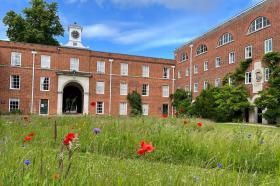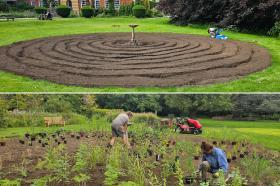
Oakley Loudon, our Jenny Rose Carey Head Gardener, reflects on a busy summer in the LMH gardens and looks ahead to exciting projects to come:
“The summer was a time of success in achieving projects, and keeping the garden in good enough form. At many points it was almost like a circus act - of spinning plates and juggling, to navigate the management of development project momentum while maintaining the garden to the degree needed, with what we have available to us. With hindsight, over a softly lush green summer, which was a boon for many reasons, the garden looked pleasant.
We have been moving forward with our plans to get the gardens into shape for the 150th anniversary of the college in 2028-9. With the removal of so much plant life in important places, for example in the borders around the Fellows’ Lawn, they have temporarily become places where reflection, time and sight has had room as we do our work behind the scenes to deeply consider and refine our vision. Time is a very interesting currency when it comes to decisions of lasting impact.
The large circle border, yet to be named, in the garden at the rear of Talbot Hall, has been largely completed, albeit with a few half hardy annuals and bulbs to be planted. This was a delight to plant and especially satisfying as the border preparation has been incredibly thorough. The vision and feel of this border next year, and in the years to come, will be something celebrate and enjoy. It has been many years since such a vibrant planting matrix of quality and interesting plants has been given to the gardens here.
A recurring theme in our department is staffing levels. Like a raucous perennial that seeds in reliable multitudes, this issue has presented itself again. The sheer scale of the LMH Garden work, intermixed with student and staff engagement work, the rampant spirit of unfortunately currently sacrificial work needed in the jungles of the Fyfield Road residences, the impact of historic tree management, tree succession, the riverside and biodiversity planning and work, and of course the future vision project management in time for the 150th, equates to a heavy plate. This workload is all contained and managed within our team, but there is a huge amount of work ahead for us as we grapple with perception of what we have to do, to achieve what is being imagined.
Another success of the year is our progress in biodiversity planning. I have been liaising with Catriona Bass and her teams from the Thames Valley Wildflower Meadow Restoration Project. This is deeply helpful, as we can use her equipment to scale up and work more efficiently on the meadows around the Hockey Pitch, and our shoulders will thank us later! We have a plan to reduce the size of the mown grass for recreational use, with a larger cutback in time for the Summer Ball schedule every three years. It should be noted that in all Catriona’s work on the meadows in and around Oxford, she was deeply impressed with our meadow spaces here at LMH and noted we are doing the most, with the most diversity, of any Oxford college. This is partly due to the methods we use, compared to the traditional methods of meadow cultivation that I deemed unnecessary, and mainly because we have such a delightfully varied site.
We have also had a complete site-wide tree survey, with thorough identification of species, which has proved incredibly rich and useful in our route to a structured and considered long term plan of tree management and tree succession planting. We now also have some excellent information that we hope will eventually be shared with the community and visitors here.
A preliminary habitat survey of the site was also carried out. This consolidated a lot of information that we already knew, and also provided plenty of ideas and considerations to deepen our consideration of action ahead. A follow-up meeting produced some great information and discussion to help us form a way forward to create a plan for the wildlife and biodiversity of our fantastic gardens.”
